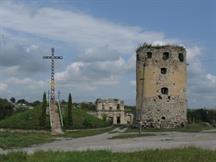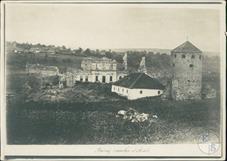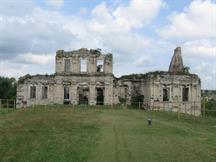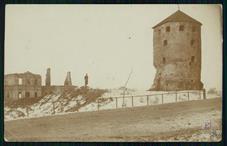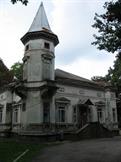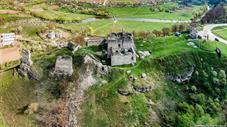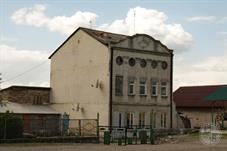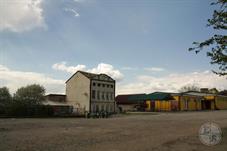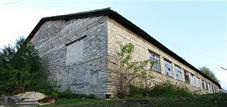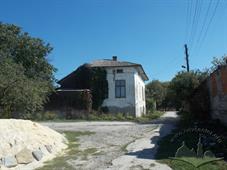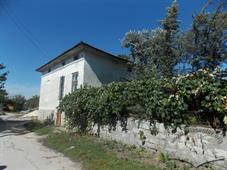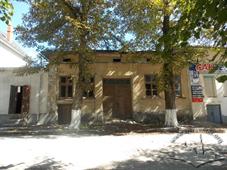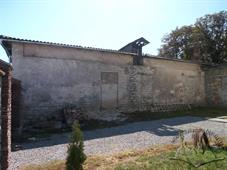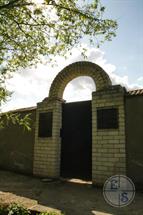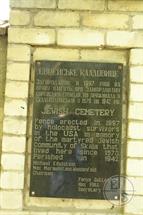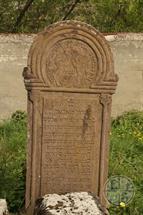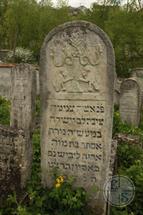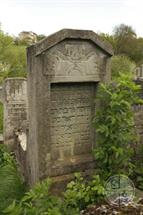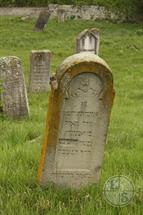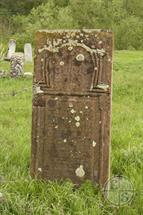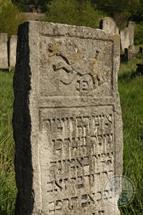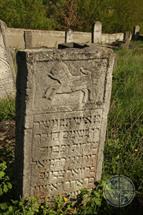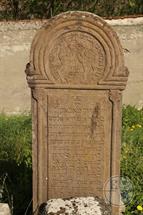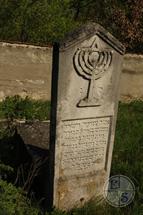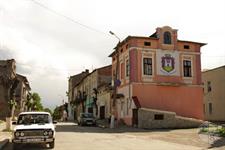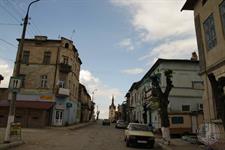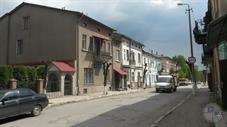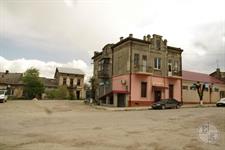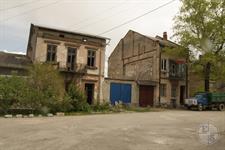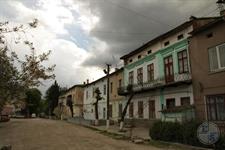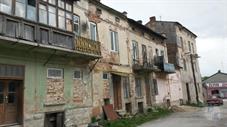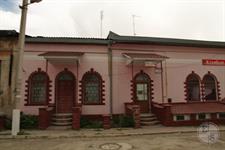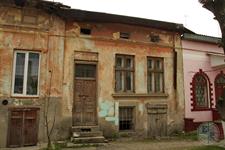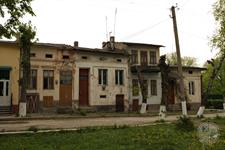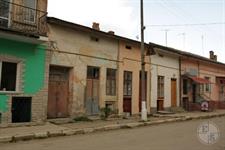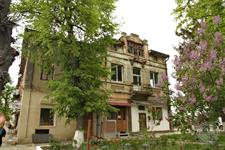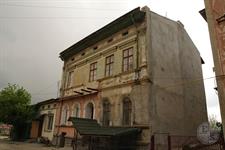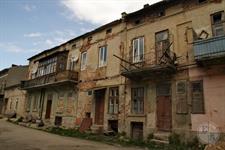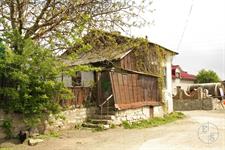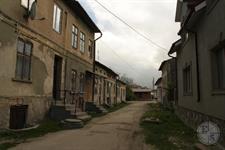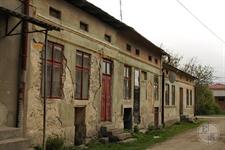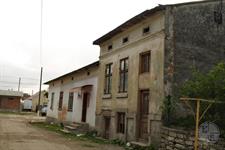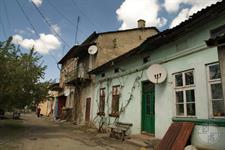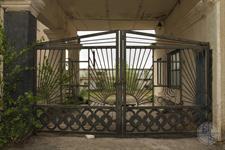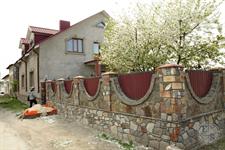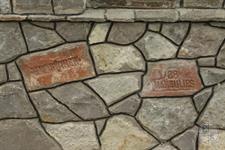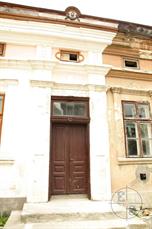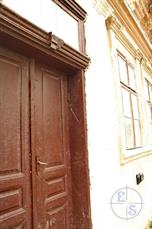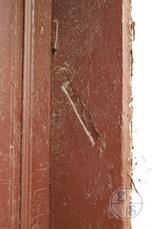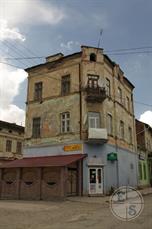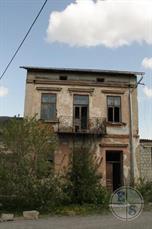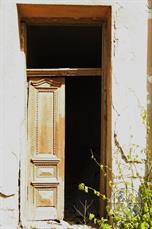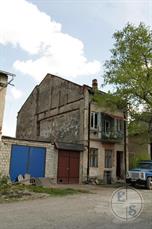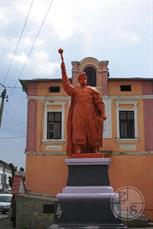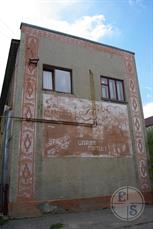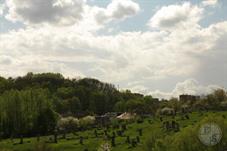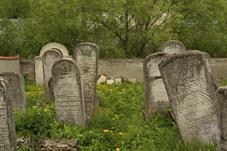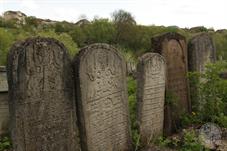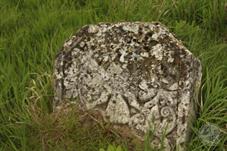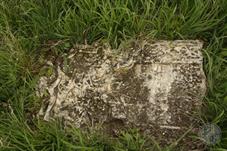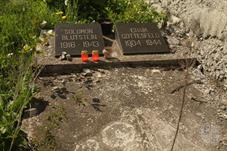Skala Podilska
Skala-Podilska, 2016
Photo of the kloyses:
A. Bondarenko ukrainaincognita.com,
Center of citys history lvivcenter.sitegist.net
A. Bondarenko ukrainaincognita.com,
Center of citys history lvivcenter.sitegist.net
Ternopil region
Up until the annexation of Ruthenia to Poland in the 14th century, Skala had been known as a fortress. At the end of the 14th century it was transferred to the jurisdiction of the Great Lithuanian Principality and in 1430 it returned to the patronage of the Kingdom of Poland. In 1518 the king reinstated the Magdeburg laws for the administration of the city. Being a rural city, Skala was many times hurt by invaders: the Tatars in 1510 and 1518, the Walachians in 1539 and, again, the Tatars in 1615. During the wars with the Swedes in mid 17th century, Skala was conquered by the Hungarians. The invasions caused much destruction and by 1665 there were only 15 inhabitants left in town. In the 19th century, Skala had become the center of the estates of a noble family, very influential in Galicia and even in Vienna, the capital, the family of the Counts of Goluchowski. The old Agenor was the governor of Galicia and Minister of Internal Affairs of the Austro-Hungarian monarchy; his son, Agenor the young, served for several years as Foreign Minister of the empire. Situated on the Galicia-Russia border, this city developed in the 19th century as a result of both legal trade and smuggling with Russia. In August of 1914, Skala was conquered by the Russian army. On their expulsion in 1915, the Russian soldiers did much damage to most houses, and especially the houses of Jews who had been evicted. From November 1918 and until May 1919 the city was under the jurisdiction of the Western Ukrainian Republic, and in 1920 the Bolcheviks ruled for 7 weeks.
The first evidence of Jews in Skala dates back to 1570. According to the census of that year, there were 10 Jewish families in town. This Jewish settlement was probably terminated by the 1648-1649 decrees and during the Swedish and Hungarian invasions. Yet, it was renewed at the end of the 17th century, developed during the 18th century (the census of 1765 mentioned that most of the inhabitants were Jewish), and reached its peak during the second half of the 19th century. The dwindling of the population started in the 1890's and early 20th century, as a result of emigration to other places within the empire and mainly to overseas lands.
With the outbreak of WWI, only a few of the affluent Jews succeeded to escape. As said, Skala fell in the hands of the Russians at the end of August 1914, but the Russian civil rule did not harass Jews in particular. However, in the summer of 1915 all Jews living near the frontier were evicted to places at least 8 kms away from the border. The Skala Jews were first sent to Chortkov and were allowed to return; after a few days they were sent to Kopychintsy and Borshchev. They suffered hunger and arduous living conditions in their exile. The resulting cholera epidemic took its toll and many died. When they were allowed to return, they found their homes destroyed (the Russian soldiers had dismantled many houses to use the wood for fire and for their trenches) and plundered of their contents by the Russian soldiers and by their Ukrainian neighbors. Having barely restored their homes, the Jews found sustenance in barter of wartime wares with the Russian Jews across the border. They exported candles, matches, alcohol, industrial products and especially cigarette paper and brought in from Russia various food products. In 1918, when the Central Powers had conquered extensive areas of Ukraine, this kind of trade prospered and some of the Skala Jews became wartime profiteers. As from November 1918, under the government of the Western Ukrainian Republic, the town Jews suffered from the incontrollable inflation and from the unstable security. The Peltura gangs raided the town several times, tormenting Jews. When the Polish army commanded by General Haller conquered the town, the soldiers abused the Jews, beat them and shaved their beards and locks. In 1920, during the Bolchevik conquest of Skala, the revolutionary government harassed Jewish business and their sustenance (goods and other assets were confiscated as belonging to the so-called “capitalist Jews”). When the war was over, it became clear that the Skala Jewish population had diminished by about 1,000 people as a result of epidemics, war casualties, dispersing in other towns and emigration.
The first evidence of Jews in Skala dates back to 1570. According to the census of that year, there were 10 Jewish families in town. This Jewish settlement was probably terminated by the 1648-1649 decrees and during the Swedish and Hungarian invasions. Yet, it was renewed at the end of the 17th century, developed during the 18th century (the census of 1765 mentioned that most of the inhabitants were Jewish), and reached its peak during the second half of the 19th century. The dwindling of the population started in the 1890's and early 20th century, as a result of emigration to other places within the empire and mainly to overseas lands.
With the outbreak of WWI, only a few of the affluent Jews succeeded to escape. As said, Skala fell in the hands of the Russians at the end of August 1914, but the Russian civil rule did not harass Jews in particular. However, in the summer of 1915 all Jews living near the frontier were evicted to places at least 8 kms away from the border. The Skala Jews were first sent to Chortkov and were allowed to return; after a few days they were sent to Kopychintsy and Borshchev. They suffered hunger and arduous living conditions in their exile. The resulting cholera epidemic took its toll and many died. When they were allowed to return, they found their homes destroyed (the Russian soldiers had dismantled many houses to use the wood for fire and for their trenches) and plundered of their contents by the Russian soldiers and by their Ukrainian neighbors. Having barely restored their homes, the Jews found sustenance in barter of wartime wares with the Russian Jews across the border. They exported candles, matches, alcohol, industrial products and especially cigarette paper and brought in from Russia various food products. In 1918, when the Central Powers had conquered extensive areas of Ukraine, this kind of trade prospered and some of the Skala Jews became wartime profiteers. As from November 1918, under the government of the Western Ukrainian Republic, the town Jews suffered from the incontrollable inflation and from the unstable security. The Peltura gangs raided the town several times, tormenting Jews. When the Polish army commanded by General Haller conquered the town, the soldiers abused the Jews, beat them and shaved their beards and locks. In 1920, during the Bolchevik conquest of Skala, the revolutionary government harassed Jewish business and their sustenance (goods and other assets were confiscated as belonging to the so-called “capitalist Jews”). When the war was over, it became clear that the Skala Jewish population had diminished by about 1,000 people as a result of epidemics, war casualties, dispersing in other towns and emigration.
During the 18th century the sustenance of the Skala Jews was based on tenancy, trade and little on crafts. From the end of the 18th century and up till WWI, the Skala Jews economy was influenced by several local factors. Being the town was located on the Russian border and with a Customs post, there were ample possibilities of smuggling. Licit and illicit trade developed, and the Jews were largely involved in it. The family of the Counts of Goluchowski, owners of the local noble estate, sympathized with the Jews and shared an extensive trade relationship with them. The Jews were their agents and intermediaries, they leased their industries (the brewery whose beer was exported, the flourmill, the spirits and liqueur distillery – the liqueurs were marketed in the entire region). The Jews owned two factories for the manufacture of etheric oils, which were also exported. More than a few were wholesalers of wheat, eggs, geese, legumes and bran – goods that were mostly imported from Russia and exported to overseas European countries. Two Jewish merchants imported beads from Italy and transferred them to Russia by different ways. The large dry-good stores were in the hands of Jews. Part of the merchants found their sustenance in markets and fairs in the surrounding towns.
Side by side with the large merchants and manufacturers, many other people made a living – intermediaries, agents, clerks and even carriers and cart owners. In the outskirts of town, some Jewish families lived from agriculture. Two of them even purchased estates by mid 19th century. Jewish craftsmen worked on all the crafts. There were tailors (some of them made low-price ready-made clothes), shoemakers, bakers, butchers, glaziers, tinsmiths, carpenters, locksmiths and blacksmiths. As said, the smuggling across the border was an important source of sustenance to many of the town's denizens. Smugglers were organized and they spread fear. Next to them, people made a living as agents, money exchangers and moneylenders. In the years 1903-1906, also people were smuggled via Skala – escapees from the Russian rulers and Jews fleeing persecution. A committee was established in Skala to assist refugees from Russia giving them temporary residence and helping them to emigrate to overseas countries.
In the 18th century there was in Skala an independent community with its own institutions and rabbis. The best known rabbis were Rabbi Joseph Hollis since about 1718 (previously the rabbi of Tysmenitsa) and Rabbi Itzhak Chayut bar Zvi Hirsch (d. 1727) who wrote “Zera Itzhak”. Rabbi Moshe bar Yehuda-Leib, who wrote “Pney Moshe”, officiated ca. 1800. Rabbi David Berchie Shapira bar Yehuda-Meir left Skala to serve in Shepetovka and then to Tluste where he died in 1850. In 1831 Rabbi Shlomo Drimmer, who wrote “Beth Shlomo” and “Shoresh Yaakov”, was appointed Rabbi of Skala and officiated devoutly for 40 years. On his death in 1872, his son Rabbi Abraham, who wrote “Be'era shel Miriam”, inherited the position and served until WWI. The number of the Chassidim of Czortkov and of Vizhnitz increased and the rivalry between them became apparent; as a result, there were two rabbis in Skala from the end of the 19th century, one for each denomination, with their own ritual slaughterers. In the early 20th century, Rabbi Israel Laufer acted as head of the Rabbinical Court side by side with Rabbi Abraham Drimmer. The old synagogue of Skala, which dated back to the end of the 18th century, was destroyed in a fire in 1911. At once they started to erect a new building, but by the outbreak of WWII it had not yet been completed. About ten prayer houses were established in town, most of them colleges of the Chassidim of Czortkov, Vizhnitz, Ottynia, Strusow, etc.
Up until WWI, the Jews of Skala had a representation in the city council that reached half of the total number of seats, and the position of Deputy Mayor was reserved for the Jews.
Towards the end of the 19th century, a group of intellectuals appeared in Skala that established in 1895 an association named “Dorshey Madda” (Pursuers of Knowledge) with the objective “to spread knowledge and especially the knowledge of our language”. By the same time the first Zionist groups were being organized. In 1908 a Hebrew school of “Saffa Berura” was founded and next to it a library. During the first year, there were 89 students in school. At the women's association “Rachel”, founded ca. 1911, there was a drama group.
Side by side with the large merchants and manufacturers, many other people made a living – intermediaries, agents, clerks and even carriers and cart owners. In the outskirts of town, some Jewish families lived from agriculture. Two of them even purchased estates by mid 19th century. Jewish craftsmen worked on all the crafts. There were tailors (some of them made low-price ready-made clothes), shoemakers, bakers, butchers, glaziers, tinsmiths, carpenters, locksmiths and blacksmiths. As said, the smuggling across the border was an important source of sustenance to many of the town's denizens. Smugglers were organized and they spread fear. Next to them, people made a living as agents, money exchangers and moneylenders. In the years 1903-1906, also people were smuggled via Skala – escapees from the Russian rulers and Jews fleeing persecution. A committee was established in Skala to assist refugees from Russia giving them temporary residence and helping them to emigrate to overseas countries.
In the 18th century there was in Skala an independent community with its own institutions and rabbis. The best known rabbis were Rabbi Joseph Hollis since about 1718 (previously the rabbi of Tysmenitsa) and Rabbi Itzhak Chayut bar Zvi Hirsch (d. 1727) who wrote “Zera Itzhak”. Rabbi Moshe bar Yehuda-Leib, who wrote “Pney Moshe”, officiated ca. 1800. Rabbi David Berchie Shapira bar Yehuda-Meir left Skala to serve in Shepetovka and then to Tluste where he died in 1850. In 1831 Rabbi Shlomo Drimmer, who wrote “Beth Shlomo” and “Shoresh Yaakov”, was appointed Rabbi of Skala and officiated devoutly for 40 years. On his death in 1872, his son Rabbi Abraham, who wrote “Be'era shel Miriam”, inherited the position and served until WWI. The number of the Chassidim of Czortkov and of Vizhnitz increased and the rivalry between them became apparent; as a result, there were two rabbis in Skala from the end of the 19th century, one for each denomination, with their own ritual slaughterers. In the early 20th century, Rabbi Israel Laufer acted as head of the Rabbinical Court side by side with Rabbi Abraham Drimmer. The old synagogue of Skala, which dated back to the end of the 18th century, was destroyed in a fire in 1911. At once they started to erect a new building, but by the outbreak of WWII it had not yet been completed. About ten prayer houses were established in town, most of them colleges of the Chassidim of Czortkov, Vizhnitz, Ottynia, Strusow, etc.
Up until WWI, the Jews of Skala had a representation in the city council that reached half of the total number of seats, and the position of Deputy Mayor was reserved for the Jews.
Towards the end of the 19th century, a group of intellectuals appeared in Skala that established in 1895 an association named “Dorshey Madda” (Pursuers of Knowledge) with the objective “to spread knowledge and especially the knowledge of our language”. By the same time the first Zionist groups were being organized. In 1908 a Hebrew school of “Saffa Berura” was founded and next to it a library. During the first year, there were 89 students in school. At the women's association “Rachel”, founded ca. 1911, there was a drama group.
During this time the economy of the Jews of Skala underwent major changes. The extent of the trade across the Russian border was limited. The USSR gradually restricted the passage of merchandise through this border and, after a few years, closed it altogether. Smuggling diminished and became extremely dangerous. The Polish authorities also restricted movement across this border and trespassers (mainly smugglers) were sentenced to long imprisonment. A number of Jewish merchants continued dealing in the wholesale of eggs, grains and legumes, and even exported. However, the average merchant, who traded in country fairs, and the shopowner were badly harmed by the steep taxing and by the competition of Polish and Ukrainian cooperatives. The craftsmen's sustenance did not change much nor did that of the few farmers (among them an estate owner with many assets). Representatives of the Jewish Intelligentsia lived in town at the time: 2 doctors, 2 dentists, several teachers and a few unemployed university graduates (Philosophy and Law), a number of clerks (bookkeepers, community clerks, etc.); one of the latter acted as Secretary of the City Council. In addition, there were a significant number of religious officers (rabbis, judges, ritual slaughterers and instructors). Carting, the transportation of merchandise and people to the train station and to the towns of Chortkov and Borshchev, continued to be a typical Jewish occupation.
In the 1930's the situation of the Jews of Skala worsened because of the increasing anti-Jewish instigations. There was an increment of merchants' bankrupcies and former benefactors had to receive aid. The situation aggravated even more with the fires that broke out in town: one in 1924, which ruined five houses and left eight families homeless; the other in 1934 left 14 families, mostly poor, completely destitute. Aid to merchants and artisans was extended by the “Merchants and Artisans Credit Union” (established in the 1920's) and mainly by the Benefactory Fund established in 1927 with assistance from the Joint; this fund granted 87 loans in 1933-1934 amounting to a total of 6,574 zloty.
In 1931 the Chevra Kadisha built a home for the aged. “Yad Harutzim” was also active in extending aid to the needy. It helped the sick with money and medicines and it provided nursing night shifts. The ritual bath, built in 1922 with Joint funds, offered free access to the poor. The Kehillah Council allotted yearly sums, apart from the Passover offerings, to assist with wood for heating the homes and warm clothes for the winter, to the maintenance of the complementary Hebrew school and the home for the aged. The basic capital for the establishment of the Credit Union in 1927 was 300 zloty. At the end of WWI, the Zionists renewed their activities in town; branches of Poalei Zion, the General Zionists, Mizrachi and the Revisionists were established. Youth organizations were also founded: Hashomer Hatzair (1920), Hanoar Hatzioni (1929), Beitar (1931) and Achva (1934). An organization to help the Chalutzim was created in 1924. In the elections to the Zionist Congress, the majority of votes went to the General Zionists. In 1935 the General Zionists received 289 votes, Mizrachi – 5 and the Working Eretz Israel party – 234. In Skala, a significant number of workers and youth were affiliated with the anti-Zionist organization Braterstwo (“Fraternity” in Polish). Its members were prosecuted and some of them even fled to the USSR. This organization reared some of the activists of the local Soviet government of 1939-1941.
Zionists were the majority in the Kehillah Council. In the elections held in 1928 (after the period of management by appointees), 7 Zionists were elected and only 1 member of the Orthodox. The results were similar in the ensuing elections to the Kehillah Council. In the City Council elected by earlier regulations in 1927, Jews received 24 seats, Poles and Ukrainians received 12 each. In 1934 new elections were held following the new regulations (with “elections geography” artifices and pressure from the authorities); 7 Poles, 5 Jews and 4 Ukrainians were elected.
The Zionists of Skala were the promoters of cultural activities. In 1921 the “Beth Ha'am” (Community House) was erected and it housed the complementary Hebrew school, youth organizations, the drama circle and the library. There were about 100 students in this school and there was also a kindergarten. The library held some 5,000 books (in Yiddish, Polish and about 800 in Hebrew). The performances of the drama circle, held until WWII, were attended not only by the Jews of Skala; the audience included members of the Polish and Ukrainian Intelligentsia.
In the 1930's the situation of the Jews of Skala worsened because of the increasing anti-Jewish instigations. There was an increment of merchants' bankrupcies and former benefactors had to receive aid. The situation aggravated even more with the fires that broke out in town: one in 1924, which ruined five houses and left eight families homeless; the other in 1934 left 14 families, mostly poor, completely destitute. Aid to merchants and artisans was extended by the “Merchants and Artisans Credit Union” (established in the 1920's) and mainly by the Benefactory Fund established in 1927 with assistance from the Joint; this fund granted 87 loans in 1933-1934 amounting to a total of 6,574 zloty.
In 1931 the Chevra Kadisha built a home for the aged. “Yad Harutzim” was also active in extending aid to the needy. It helped the sick with money and medicines and it provided nursing night shifts. The ritual bath, built in 1922 with Joint funds, offered free access to the poor. The Kehillah Council allotted yearly sums, apart from the Passover offerings, to assist with wood for heating the homes and warm clothes for the winter, to the maintenance of the complementary Hebrew school and the home for the aged. The basic capital for the establishment of the Credit Union in 1927 was 300 zloty. At the end of WWI, the Zionists renewed their activities in town; branches of Poalei Zion, the General Zionists, Mizrachi and the Revisionists were established. Youth organizations were also founded: Hashomer Hatzair (1920), Hanoar Hatzioni (1929), Beitar (1931) and Achva (1934). An organization to help the Chalutzim was created in 1924. In the elections to the Zionist Congress, the majority of votes went to the General Zionists. In 1935 the General Zionists received 289 votes, Mizrachi – 5 and the Working Eretz Israel party – 234. In Skala, a significant number of workers and youth were affiliated with the anti-Zionist organization Braterstwo (“Fraternity” in Polish). Its members were prosecuted and some of them even fled to the USSR. This organization reared some of the activists of the local Soviet government of 1939-1941.
Zionists were the majority in the Kehillah Council. In the elections held in 1928 (after the period of management by appointees), 7 Zionists were elected and only 1 member of the Orthodox. The results were similar in the ensuing elections to the Kehillah Council. In the City Council elected by earlier regulations in 1927, Jews received 24 seats, Poles and Ukrainians received 12 each. In 1934 new elections were held following the new regulations (with “elections geography” artifices and pressure from the authorities); 7 Poles, 5 Jews and 4 Ukrainians were elected.
The Zionists of Skala were the promoters of cultural activities. In 1921 the “Beth Ha'am” (Community House) was erected and it housed the complementary Hebrew school, youth organizations, the drama circle and the library. There were about 100 students in this school and there was also a kindergarten. The library held some 5,000 books (in Yiddish, Polish and about 800 in Hebrew). The performances of the drama circle, held until WWII, were attended not only by the Jews of Skala; the audience included members of the Polish and Ukrainian Intelligentsia.
The Red Army ocuupied Skala on September 17, 1939. Very soon the population understood the nature of the new regime. Merchants and peddlers lost their sustenance since private trade was banned and their wares were confiscated. Zionist leaders were persecuted and were forced to escape. In the summer of 1940, the Soviet authorities sent most refugees from the West to the hindmost parts of the USSR, as they did in other towns. The eviction was carried out without prior notice, at night, and people were not allowed to take any belongings.
After the outbreak of war between Germany and the USSR, tens of Jewish young men of Skala were drafted to the Red Army. When the Soviets left Skala, a number of Jewish clerks and administration aides followed them, in fear of retaliation from the Germans and the Ukrainians. The government of the town passed on to the hands of the Ukrainian militia, which arrested a number of Jews and raided homes. There were cases of Jews beaten up by the Ukrainians, looting and one person was killed when a hand grenade was thrown into a Jewish home. These actions did not turn into a pogrom despite the fact that in nearby villages the Ukrainian farmers murdered many Jews.
The Hungarian army occupied Skala on July 14, 1941. The Hungarians drafted Jews to forced labor under the supervision of Ukrainian guards, mainly to build a bridge across the Zbrucz, which had been destroyed by the Red Army during their retreat. On July 25, 1941 the Military Commander of Skala summoned 15 of the Jewish leaders, headed by Rabbi Yehuda Drimmer, and demanded immediate provision of 60 kg leather for boots, 10 pairs of boots, 10 kg coffee, several kilograms of pepper and various luxury wares. Hostages were taken to ensure the supplies. The demand was fulfilled in time. By the same time – end of July – the Jews of Skala saw the heartbreaking march of thousands of Jews from Carpatho-Ruthenia, guarded by Ukrainians, taken to the old Russian border and from there to Kamenets-Podolski. The Skala Jews collected food and clothes and provided them with carts to carry the exhausted. All those people perished in massive killings in the environs of Kamenets-Podolski. Only three escaped and made it to Skala. The Judenrat provided them with false documents to enable them to go to Hungary. And indeed all three survived the war.
In early August 1941 Skala's dominion was taken over by the Germans. The seat of the civil administration was located in what had been the estate of the Count of Goluchowski. In Skala there were also headquarters of the German border police and their commander had a weighty position and much influence in regards to the Jews of Skala. The Judenrat was established short after the German occupation. It comprised seven persons: Mordechai Weidberg who headed it, Rabbi Drimmer, Meyer Zysie Tabak, Nissen Olinger, Joseph Jagget, Abraham Bilgoray, Eliezer Fisch. Side by side with the Judenrat, a Jewish police was created.
The main function of the Judenrat, as in other places, was to provide the Germans with Jewish labor, goods and money. Early on, the Germans and the Ukrainian militia hunted men for forced labor. To make a list of men fit for labor and put some order in their enrolment, the Judenrat made a census of the Jews of Skala, and instituted a labor department. Wealthy Jews evaded labor by paying, through the labor department, the wages of their replacements. Many poor Jews found sustenance in this system. The organization of forced labor by the Judenrat lessened significantly the wild kidnappings and the hunts on the streets. The Germans demanded every day 40-50 laborers for the border police farm and 80-100 laborers for the civil headquarters in the Goluchowski estate. Work was hard. It lasted the whole day and some of the Ukrainian supervisors beat and abused Jews. When less than the quota showed up, the Germans attacked the Judenrat and the Jewish police and sometimes beat them.
Contributions that the Germans demanded from the Judenrat were mainly in the form of rare goods. These were either taken from the Jews, or money had to be paid for their purchase. For this purpose the Judenrat created a financing commission, which assessed the financial situation of the Jews and fixed the tax per capita. The Jewish police collected the taxes from those who refused to pay.
The German authorities did not order the establishment of a Jewish ghetto in Skala. Jews concentrated mainly in the marketplace and on neighboring streets and there was a larger gathering in the suburb of Stara-Skala. Officially, the entrance of Jews to gentile neighborhoods was forbidden. Later on (in 1942) Jewish homes were marked with a Star of David on the outer wall or on the windows. Compared with the conditions in other places, where Jews were separated from the rest of the population, the situation of the Jews of Skala was better; hunger and poverty were not a common sight. People sold their belongings and secretly traded with the rest of the population. For the poorest, the Judenrat opened a public kitchen in the basement of the “Port Arthur” synagogue. Once a day, it catered warm soup and a ration of bread. In the aid to the needy, the JSS, managed by Gedalia Lachman, collaborated with the Judenrat.
In October 1941 more than 100 Jews, who had been evicted from their villages and pillaged by the Ukrainians, came to Skala. By the end of October, the Jewish population of Skala had increased to 1550, and so had the number of charity recipients.
In the winter of 1941-1942, the Jews of Skala, as in other places, were ordered to submit to the German authorities all the furs in their possession. But the worst of the rulings were the frequent transports to neighboring labor camps. The first transport was in late November or early December 1941. The German Arbeitsamt in Chortkov ordered the Judenrat to bring 50 men to the pickup station in that town. Other Judenrats in the area received similar orders. The Judenrat of Skala prepared a list of bachelors aged 18-35. They were summoned and the following day they were taken in carts accompanied by a member of the Judenrat. And yet, 22 Jews succeeded to escape from the pickup station and returned to Skala; the rest were taken to the camp in Borki-Wielkie. Since then, the Judenrat kept permanent contact with the inmates of this camp through N. Olinger. Fortnightly, two Judenrat carts would bring food, clothes and medicines to the camp's inmates. The Judenrat's lobbying and heavy bribes enabled the release of some of them after several weeks.
In February of 1942, the Germans once again demanded a quota of men for labor camp. The Judenrat's attempts at bribing the Arbeitsamt clerks failed. This time none of the summoned Jews responded, as they already knew the frightful conditions of the camps. Thus the Ukrainian police, together with the Jewish police, went on a dodger hunt in working places and homes. Those men were sent over to Borshchev, which now served as a pickup station. Still some escaped the transport by means of bribery. Once again, 18 Jews of Skala managed to escape from Borshchev and the rest were transported to Borki-Wielkie. The Judenrat continued to send packages to the camp and trying to redeem a few inmates.
At the end of March 1942, the remaining Jews of the neighboring villages were uprooted and brought to Skala – from Burdyakovtse, Losyach, Gushtyn, Tsygany, Turil'che, Mushkatuvka, Volkovtse, Nivra, Germakowka. The influx of refugees caused lodging problems in Skala and increased the number of the poor. It was very difficult for the Judenrat to accommodate the incoming refugees and they feared that the Germans would order to close a ghetto in Skala to meet the demands of the Ukrainian population.
A few days after the refugees had been brought into town, the Judenrat received an order that all Jewish men aged 14-60 were to present themselves to be registered at the Arbeitsamt in Borshchev on April 2, 1942 (the first day of Passover 5702), seemingly to receive identification papers. The same order was also given to the other communities in the area. The Judenrat prepared the required lists. According to one version, the members of the Judenrat and of the Jewish police were to present themselves, too. Panic struck the Jews of Skala, who did not know what to do – to present themselves, to stay behind, to hide, to flee. People who had not worked officially for the Germans tried feverishly to secure a work card – in some cases paying large amounts of money, with the help of the Judenrat. Hundreds of Jews, some in carts and some afoot, left Skala for Borshchev. There they discovered that a trap had been set: German and Ukrainian policemen surrounded the town, they concentrated all the Jews of the region in a tobacco storage area and kept them there to be transported to the camps of Borki-Wielkie and Stupki. Afew, bearers of “good” work cards, managed to be released. Among those sent away, there were 75 (or 84) Jews from Skala, and many of those expelled from the above- mentioned villages. The Judenrat of Skala continued the contact with the camp of Borki-Wielkie and sent food and clothes to the inmates. The liaison Chaim Brettler travelled several times to the town of Borki-Wielkie, stayed there a few days each time, and was in contact with the Jewish foremen of the camp. With heavy bribes he succeeded to release sick and exhausted people from Skala, or to replace them with relatives who volunteered.
A short time after the Passover round up, in mid May 1942, all the members of the Judenrat, clerks and Jewish policemen were summoned to the commander of the border police with the claim that they had to present their own work cards for inspection. The commander examined more than 50 people, released 30 of them (among them the members of the Judenrat), and sent the rest to prison in Chortkov. There they were abused, beaten and ordered to do humiliating works. The Judenrat interceded, bribed, and a few were released. The rest were sent, together with Jews from other places, to the labor camps in Kamionka and Romanove-Selo. The round ups in Skala continued and again a group of men were sent to the camps of Borki-Wielkie and Stupki. According to one version, the summoning of the members of the Judenrat and the Jewish policemen was some kind of retaliation for not complying with the demands of the Germans and supplying the quota of men to labor camps.
At the end of June 1942, the Judenrat received the order to provide 75 young women for the labor camp in Jagielnica. The Judenrat sent only six. The commander of the border police completed the number in the course of a night hunt. Some of the women were freed by means of lobbying and bribery. In the end, only 20 were sent away.
On September 25, 1942 (the eve of Succot 5703), the Gestapo officer from Chortkov came to Skala. Accompanied by three members of the Judenrat he passed the Jewish neighborhood to see if more Jews from the area could be accommodated there. As accustomed during visits of Gestapo officers, the Judenrat members gave him money to prevent eventual adversities. But nothing helped. The following day, September 26, the aktsia started. Gestapo people arrived from Chortkov in cars. The German and Ukrainian police surrounded the town and called the Judenrat and the Jewish policemen to assist and supervise the gathering of assets from the vacated houses. More than a few Jews succeeded to escape to the surrounding fields, to the forest or to the hiding places previously prepared in their houses. The policemen scanned the entire town, went from house to house, took out all the Jews and sought the hideouts. Those caught were concentrated in the former post of the Polish border police. The area had been previously closed with a barbed wire fence under the claim that it was being prepared as a camp for French POW's. The Jews concentrated there were examined and robbed. In the evening the aktsia ceased. Until noon the following day, the chase after the runaways continued. Some 700 Jews were caught in this action. More than 30 were murdered on the spot. The rest were taken to the station and transported to the Janowska camp in Lvov. Among the evicted where members of the Judenrat, Rabbi Drimmer and Eliezer Fisch, and two Jewish policemen. After the selection in Lvov, part of the people – the exhausted, the aged, women and children – were sent to the extermination camp in Belzec and the rest were left in Janowska. Before long, most of them perished as a result of the lethal conditions of the camp.
After the action in Skala the Germans ordered to bury the murdered Jews in a common pit in the cemetery. Under German orders, the Ukrainian farmers loaded the belongings of the Jews on carts and took them to the synagogues. Thanks to their escape or hideouts, half of the Jews of Skala were saved and returned to live in town several days later.
Two weeks after the action, the authorities informed the Judenrat that the remaining Jews were to leave Skala for the ghetto in Borshchev not later than October 22, 1942, together with the Jews of Ozeryany, Mielnica and Koroluvka. The expulsion took place on the set date. The evicted took along their remaining belongings. Only several tens of Jews were left in Skala. These were enlisted to work in the border police farm, and in the Goluchowski estate, private servants to the Germans, and rags and scrap collectors (bearing Gestapo certificates as “Jews important to the German administration”; some of them paid large amounts for these certificates). They had only about six months to live in relative calm. On March 6, 1943, the Germans expelled part of them to Borshchev (excluding those working in the farm and estate, who were concentrated in their work places). Among the exiles were the last remaining members of the Judenrat. As from this moment, Skala was officially “Judenrein”. The border police and the Ukrainian policemen sought ceaselessly those hidden in town and in the surroundings, caught them and shot them in the cemetery. One day in the autumn of 1943, the German police surrounded the Goluchowski estate and murdered all the Jewish laborers. The Jews from the border police farm were sent to the Janowska camp on October 19, 1943.
Many Jews stayed secretly in town or in its environs, either hidden by Christians or in hideouts in the forest (mainly near the villages Tsygany and Zielince). The Jew hunt and murder by the Ukrainians, the Germans and the nationalist Ukrainian partisans continued until the liberation of the area by the Soviet army on March 25, 1944. More than 200 Jews perished in the forest near Skala alone. Some of those hidden could not stand the permanent tension, the fear, the cold and the hunger and came to work for the Germans in the small camps near the neighboring villages, like Dubraniovka near Ozeryany or Lisovtse near Tluste. In Lisovtse conditions were bearable thanks to two Germans, the camp's managers. And indeed, all the Jews that worked there outlived the war.
A number of young men from Skala escaped to the forest to join the Jewish Partisans Unit (about 65 men) under the command of Yehoshua (Oziasz) Zucker and Lonek Jung from Borshchev, which was active in the forests of Tsygany and Zielince during the period of March-December, 1943. At the end of December the Germans surrounded the unit and all its men fell fighting.
After the liberation on March 25, 1944, the few survivors returned to town. And yet, several days later the Germans reconquered Skala. The Jews tried to hide, and some managed to escape in the wake of the Soviet army. The Germans stayed in Skala for about two weeks and killed 4 Jews. When the Soviets finally conquered the town on April 6, 1944, the Jewish survivors assisted the Soviets to punish the Ukrainians who had committed crimes against Jews. The Soviet Command, in July 1944, established in Skala a “Special Committee to examine Nazi crimes in the area of Skala”. Several Ukrainians arrested were shot when they attempted to escape. More than ten were sentenced to many years of forced labor. A forest man, who set fire to a hideout and caused the death of 21 Jews, was sentenced to death.
Some 150 Skala Jews survived the war. Some hid, 5-6 survived labor camps (out of about 400), and the rest were saved in the USSR.
The Jews that survived could not stay in Skala long. The town was in ruins, the atmosphere filled with antisemitism; shortly after the liberation, nationalist Ukrainians from Skala killed a Jew. The handful of survivors left for Poland, and from there to Israel and other countries. On their departure from Skala they took along 39 Torah Scrolls that had been saved. These scrolls had been taken out of the prayer houses back in 1941 at the time of the German invasion, hidden in a storage room of the Goluchowski estate. Later, when the Germans ordered the Jews to throw away the Torah Scrolls, they hid them in the attic of one of the houses in town.
Source www.jewishgen.org
Photos by Eugene Shnaider
After the outbreak of war between Germany and the USSR, tens of Jewish young men of Skala were drafted to the Red Army. When the Soviets left Skala, a number of Jewish clerks and administration aides followed them, in fear of retaliation from the Germans and the Ukrainians. The government of the town passed on to the hands of the Ukrainian militia, which arrested a number of Jews and raided homes. There were cases of Jews beaten up by the Ukrainians, looting and one person was killed when a hand grenade was thrown into a Jewish home. These actions did not turn into a pogrom despite the fact that in nearby villages the Ukrainian farmers murdered many Jews.
The Hungarian army occupied Skala on July 14, 1941. The Hungarians drafted Jews to forced labor under the supervision of Ukrainian guards, mainly to build a bridge across the Zbrucz, which had been destroyed by the Red Army during their retreat. On July 25, 1941 the Military Commander of Skala summoned 15 of the Jewish leaders, headed by Rabbi Yehuda Drimmer, and demanded immediate provision of 60 kg leather for boots, 10 pairs of boots, 10 kg coffee, several kilograms of pepper and various luxury wares. Hostages were taken to ensure the supplies. The demand was fulfilled in time. By the same time – end of July – the Jews of Skala saw the heartbreaking march of thousands of Jews from Carpatho-Ruthenia, guarded by Ukrainians, taken to the old Russian border and from there to Kamenets-Podolski. The Skala Jews collected food and clothes and provided them with carts to carry the exhausted. All those people perished in massive killings in the environs of Kamenets-Podolski. Only three escaped and made it to Skala. The Judenrat provided them with false documents to enable them to go to Hungary. And indeed all three survived the war.
In early August 1941 Skala's dominion was taken over by the Germans. The seat of the civil administration was located in what had been the estate of the Count of Goluchowski. In Skala there were also headquarters of the German border police and their commander had a weighty position and much influence in regards to the Jews of Skala. The Judenrat was established short after the German occupation. It comprised seven persons: Mordechai Weidberg who headed it, Rabbi Drimmer, Meyer Zysie Tabak, Nissen Olinger, Joseph Jagget, Abraham Bilgoray, Eliezer Fisch. Side by side with the Judenrat, a Jewish police was created.
The main function of the Judenrat, as in other places, was to provide the Germans with Jewish labor, goods and money. Early on, the Germans and the Ukrainian militia hunted men for forced labor. To make a list of men fit for labor and put some order in their enrolment, the Judenrat made a census of the Jews of Skala, and instituted a labor department. Wealthy Jews evaded labor by paying, through the labor department, the wages of their replacements. Many poor Jews found sustenance in this system. The organization of forced labor by the Judenrat lessened significantly the wild kidnappings and the hunts on the streets. The Germans demanded every day 40-50 laborers for the border police farm and 80-100 laborers for the civil headquarters in the Goluchowski estate. Work was hard. It lasted the whole day and some of the Ukrainian supervisors beat and abused Jews. When less than the quota showed up, the Germans attacked the Judenrat and the Jewish police and sometimes beat them.
Contributions that the Germans demanded from the Judenrat were mainly in the form of rare goods. These were either taken from the Jews, or money had to be paid for their purchase. For this purpose the Judenrat created a financing commission, which assessed the financial situation of the Jews and fixed the tax per capita. The Jewish police collected the taxes from those who refused to pay.
The German authorities did not order the establishment of a Jewish ghetto in Skala. Jews concentrated mainly in the marketplace and on neighboring streets and there was a larger gathering in the suburb of Stara-Skala. Officially, the entrance of Jews to gentile neighborhoods was forbidden. Later on (in 1942) Jewish homes were marked with a Star of David on the outer wall or on the windows. Compared with the conditions in other places, where Jews were separated from the rest of the population, the situation of the Jews of Skala was better; hunger and poverty were not a common sight. People sold their belongings and secretly traded with the rest of the population. For the poorest, the Judenrat opened a public kitchen in the basement of the “Port Arthur” synagogue. Once a day, it catered warm soup and a ration of bread. In the aid to the needy, the JSS, managed by Gedalia Lachman, collaborated with the Judenrat.
In October 1941 more than 100 Jews, who had been evicted from their villages and pillaged by the Ukrainians, came to Skala. By the end of October, the Jewish population of Skala had increased to 1550, and so had the number of charity recipients.
In the winter of 1941-1942, the Jews of Skala, as in other places, were ordered to submit to the German authorities all the furs in their possession. But the worst of the rulings were the frequent transports to neighboring labor camps. The first transport was in late November or early December 1941. The German Arbeitsamt in Chortkov ordered the Judenrat to bring 50 men to the pickup station in that town. Other Judenrats in the area received similar orders. The Judenrat of Skala prepared a list of bachelors aged 18-35. They were summoned and the following day they were taken in carts accompanied by a member of the Judenrat. And yet, 22 Jews succeeded to escape from the pickup station and returned to Skala; the rest were taken to the camp in Borki-Wielkie. Since then, the Judenrat kept permanent contact with the inmates of this camp through N. Olinger. Fortnightly, two Judenrat carts would bring food, clothes and medicines to the camp's inmates. The Judenrat's lobbying and heavy bribes enabled the release of some of them after several weeks.
In February of 1942, the Germans once again demanded a quota of men for labor camp. The Judenrat's attempts at bribing the Arbeitsamt clerks failed. This time none of the summoned Jews responded, as they already knew the frightful conditions of the camps. Thus the Ukrainian police, together with the Jewish police, went on a dodger hunt in working places and homes. Those men were sent over to Borshchev, which now served as a pickup station. Still some escaped the transport by means of bribery. Once again, 18 Jews of Skala managed to escape from Borshchev and the rest were transported to Borki-Wielkie. The Judenrat continued to send packages to the camp and trying to redeem a few inmates.
At the end of March 1942, the remaining Jews of the neighboring villages were uprooted and brought to Skala – from Burdyakovtse, Losyach, Gushtyn, Tsygany, Turil'che, Mushkatuvka, Volkovtse, Nivra, Germakowka. The influx of refugees caused lodging problems in Skala and increased the number of the poor. It was very difficult for the Judenrat to accommodate the incoming refugees and they feared that the Germans would order to close a ghetto in Skala to meet the demands of the Ukrainian population.
A few days after the refugees had been brought into town, the Judenrat received an order that all Jewish men aged 14-60 were to present themselves to be registered at the Arbeitsamt in Borshchev on April 2, 1942 (the first day of Passover 5702), seemingly to receive identification papers. The same order was also given to the other communities in the area. The Judenrat prepared the required lists. According to one version, the members of the Judenrat and of the Jewish police were to present themselves, too. Panic struck the Jews of Skala, who did not know what to do – to present themselves, to stay behind, to hide, to flee. People who had not worked officially for the Germans tried feverishly to secure a work card – in some cases paying large amounts of money, with the help of the Judenrat. Hundreds of Jews, some in carts and some afoot, left Skala for Borshchev. There they discovered that a trap had been set: German and Ukrainian policemen surrounded the town, they concentrated all the Jews of the region in a tobacco storage area and kept them there to be transported to the camps of Borki-Wielkie and Stupki. Afew, bearers of “good” work cards, managed to be released. Among those sent away, there were 75 (or 84) Jews from Skala, and many of those expelled from the above- mentioned villages. The Judenrat of Skala continued the contact with the camp of Borki-Wielkie and sent food and clothes to the inmates. The liaison Chaim Brettler travelled several times to the town of Borki-Wielkie, stayed there a few days each time, and was in contact with the Jewish foremen of the camp. With heavy bribes he succeeded to release sick and exhausted people from Skala, or to replace them with relatives who volunteered.
A short time after the Passover round up, in mid May 1942, all the members of the Judenrat, clerks and Jewish policemen were summoned to the commander of the border police with the claim that they had to present their own work cards for inspection. The commander examined more than 50 people, released 30 of them (among them the members of the Judenrat), and sent the rest to prison in Chortkov. There they were abused, beaten and ordered to do humiliating works. The Judenrat interceded, bribed, and a few were released. The rest were sent, together with Jews from other places, to the labor camps in Kamionka and Romanove-Selo. The round ups in Skala continued and again a group of men were sent to the camps of Borki-Wielkie and Stupki. According to one version, the summoning of the members of the Judenrat and the Jewish policemen was some kind of retaliation for not complying with the demands of the Germans and supplying the quota of men to labor camps.
At the end of June 1942, the Judenrat received the order to provide 75 young women for the labor camp in Jagielnica. The Judenrat sent only six. The commander of the border police completed the number in the course of a night hunt. Some of the women were freed by means of lobbying and bribery. In the end, only 20 were sent away.
On September 25, 1942 (the eve of Succot 5703), the Gestapo officer from Chortkov came to Skala. Accompanied by three members of the Judenrat he passed the Jewish neighborhood to see if more Jews from the area could be accommodated there. As accustomed during visits of Gestapo officers, the Judenrat members gave him money to prevent eventual adversities. But nothing helped. The following day, September 26, the aktsia started. Gestapo people arrived from Chortkov in cars. The German and Ukrainian police surrounded the town and called the Judenrat and the Jewish policemen to assist and supervise the gathering of assets from the vacated houses. More than a few Jews succeeded to escape to the surrounding fields, to the forest or to the hiding places previously prepared in their houses. The policemen scanned the entire town, went from house to house, took out all the Jews and sought the hideouts. Those caught were concentrated in the former post of the Polish border police. The area had been previously closed with a barbed wire fence under the claim that it was being prepared as a camp for French POW's. The Jews concentrated there were examined and robbed. In the evening the aktsia ceased. Until noon the following day, the chase after the runaways continued. Some 700 Jews were caught in this action. More than 30 were murdered on the spot. The rest were taken to the station and transported to the Janowska camp in Lvov. Among the evicted where members of the Judenrat, Rabbi Drimmer and Eliezer Fisch, and two Jewish policemen. After the selection in Lvov, part of the people – the exhausted, the aged, women and children – were sent to the extermination camp in Belzec and the rest were left in Janowska. Before long, most of them perished as a result of the lethal conditions of the camp.
After the action in Skala the Germans ordered to bury the murdered Jews in a common pit in the cemetery. Under German orders, the Ukrainian farmers loaded the belongings of the Jews on carts and took them to the synagogues. Thanks to their escape or hideouts, half of the Jews of Skala were saved and returned to live in town several days later.
Two weeks after the action, the authorities informed the Judenrat that the remaining Jews were to leave Skala for the ghetto in Borshchev not later than October 22, 1942, together with the Jews of Ozeryany, Mielnica and Koroluvka. The expulsion took place on the set date. The evicted took along their remaining belongings. Only several tens of Jews were left in Skala. These were enlisted to work in the border police farm, and in the Goluchowski estate, private servants to the Germans, and rags and scrap collectors (bearing Gestapo certificates as “Jews important to the German administration”; some of them paid large amounts for these certificates). They had only about six months to live in relative calm. On March 6, 1943, the Germans expelled part of them to Borshchev (excluding those working in the farm and estate, who were concentrated in their work places). Among the exiles were the last remaining members of the Judenrat. As from this moment, Skala was officially “Judenrein”. The border police and the Ukrainian policemen sought ceaselessly those hidden in town and in the surroundings, caught them and shot them in the cemetery. One day in the autumn of 1943, the German police surrounded the Goluchowski estate and murdered all the Jewish laborers. The Jews from the border police farm were sent to the Janowska camp on October 19, 1943.
Many Jews stayed secretly in town or in its environs, either hidden by Christians or in hideouts in the forest (mainly near the villages Tsygany and Zielince). The Jew hunt and murder by the Ukrainians, the Germans and the nationalist Ukrainian partisans continued until the liberation of the area by the Soviet army on March 25, 1944. More than 200 Jews perished in the forest near Skala alone. Some of those hidden could not stand the permanent tension, the fear, the cold and the hunger and came to work for the Germans in the small camps near the neighboring villages, like Dubraniovka near Ozeryany or Lisovtse near Tluste. In Lisovtse conditions were bearable thanks to two Germans, the camp's managers. And indeed, all the Jews that worked there outlived the war.
A number of young men from Skala escaped to the forest to join the Jewish Partisans Unit (about 65 men) under the command of Yehoshua (Oziasz) Zucker and Lonek Jung from Borshchev, which was active in the forests of Tsygany and Zielince during the period of March-December, 1943. At the end of December the Germans surrounded the unit and all its men fell fighting.
After the liberation on March 25, 1944, the few survivors returned to town. And yet, several days later the Germans reconquered Skala. The Jews tried to hide, and some managed to escape in the wake of the Soviet army. The Germans stayed in Skala for about two weeks and killed 4 Jews. When the Soviets finally conquered the town on April 6, 1944, the Jewish survivors assisted the Soviets to punish the Ukrainians who had committed crimes against Jews. The Soviet Command, in July 1944, established in Skala a “Special Committee to examine Nazi crimes in the area of Skala”. Several Ukrainians arrested were shot when they attempted to escape. More than ten were sentenced to many years of forced labor. A forest man, who set fire to a hideout and caused the death of 21 Jews, was sentenced to death.
Some 150 Skala Jews survived the war. Some hid, 5-6 survived labor camps (out of about 400), and the rest were saved in the USSR.
The Jews that survived could not stay in Skala long. The town was in ruins, the atmosphere filled with antisemitism; shortly after the liberation, nationalist Ukrainians from Skala killed a Jew. The handful of survivors left for Poland, and from there to Israel and other countries. On their departure from Skala they took along 39 Torah Scrolls that had been saved. These scrolls had been taken out of the prayer houses back in 1941 at the time of the German invasion, hidden in a storage room of the Goluchowski estate. Later, when the Germans ordered the Jews to throw away the Torah Scrolls, they hid them in the attic of one of the houses in town.
Source www.jewishgen.org
Photos by Eugene Shnaider

- Home
- Shtetls
- Vinnytsia region
- Volyn region
- Dnipro region
- Donetsk region
- Zhytomyr region
- Zakarpattia region
- Zaporizhzhia region
- Ivano-Frankivsk region
- Kyiv region
- Kropyvnytskyi region
- Luhansk region
- Lviv region
- Mykolayiv region
- Odessa region
- Poltava region
- Rivne region
- Sumy region
- Ternopil region
- Kharkiv region
- Kherson region
- Khmelnytskyi region
- Chernihiv region
- Chernivtsi region
- Cherkasy region
- Crimea
- Synagogues
- Cemeteries
- Objects & guides
- Gallery
- History
- Contact
Jewish towns of Ukraine
Jewish towns of Ukraine
My shtetl
My shtetl
Donate
